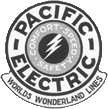Return to ERHA homepage
 Pacific Electric
Santa Ana-Huntington Beach Line
Pacific Electric
Santa Ana-Huntington Beach Line
Introduction:
This cross-country line was built by old PE to draw beach patronage to Huntington Beach from Santa Ana rather than to Santa Ana's logical beach town, Newport Beach. The reason was Mr. Huntington's large enterprises on foot in the community named after him; one of the largest such undertakings was the great hotel which depended almost entirely on holiday seekers for patronage. It proved insufficient, however, to make Huntington Beach a successful contender with Newport-Balboa for Santa Ana. The line early lapsed into a desuetude and was one of the earliest casualties of the PE rail empire.
Route:
From Santa Ana Pacific Electric Station via private right-of-way to New Delhi, Acelga, Talbert and Bushard to Huntington Beach.
Mileage:
| Santa Ana | 0.00 |
| New Delhi | 2.69 |
| Acelga | 5.60 |
| Talbert | 8.16 |
| Bushard | 10.53 |
| Huntington Beach | 13.31 |
History:
This line was built in 1907 by the Pacific Electric Land Co., a Huntington corporation. Principle construction work occurred in May and June of that year. As PE Land Co was not an operator, it leased all of its lines to
PE for an indefinite term under verbal agreement by PE Ry. to pay interest on investment and all costs of maintenance.
As this line traversed a highly developed sugar beet area, it proved profitable to construct two sizeable spurs to serve the Holly Sugar and the Southern California Sugar companies; these spurs were built in 1911 and 1908 respectively and aggregated 4.41 miles in length.
On September 15, 1911, PE Land Co. granted, sold and conveyed unto new PE all
its properties.
New PE continued to operate this line, for a while even continuing cars to Newport.
This line was operated by PE until a 1922 flood washed out a bridge; as there was but one daily round trip operated at that time, and as freight service could be provided from either Huntington Beach or Santa Ana, through
passenger service was thereupon abandoned (March, 1922). Segments of this line still are operated for freight only.
Equipment:
It is extremely difficult to pin definite car types down insofar as this line is concerned. Old records indicate that through 1911, at least, heavy cars (800s) were employed. Thereafter, the picture is unclear. It is probable that the three 400s assigned to Santa Ana from 1916 to 1922 were used on this line; these were almost certainly cars 400, 401, and 402.
Track:
This line was laid in conformity to PE standards of the time; 60 lb.T-rail, redwood ties, dirt ballast, all on private right-of-way.
Electrical Facilities:
None on the line; energy received from Santa Ana substation primarily.
Car Storage:
Equipment assigned to this line was stored at Santa Ana Pacific Electric Station and at Huntington Beach.
Freight:
In old sugar beet days, this was an excellent freight line, but with the decline of that industry, it was axiomatic that this line should fall into relative obscurity. As of 1938, the stub lines (Greenville and Dyer) accounted for but $8,082 in revenues. (Greenville was at MP 4.9; the Dyer branch took off at MP 3.5 and was 0.8 miles long.)
Air Base Extension:
The establishment of the Santa Ana Army Air Base in 1942 brought about demand by the government for direct rail service. As a result PE built a single-track line which was owned by the government. No passenger
service was provided; freight was exchanged at Greenville.
Passengers:
No records available.
Miscellaneous:
Probably no other line on the PE system could find less reason for existence than this one. It may validly be cited as a telling example of the futility of attempting to contort normal passenger needs to fit an artificial mold.
Effective June 16, 1948, PE purchased and began operating over (diesel) 11.38 miles of SP trackage: Stanton to Los Alamitos (4.48 miles), and Stanton to Wintersburg (6.67 miles) plus west leg of wye at Stanton. In addition PE acquired ownership of trackage it already operated over: Wintersburg to Weibling (1.10 miles), and Weibling to Huntington Beach (La Bolsa Line), 2.66 miles. This enabled diesel freights to reach Huntington Beach and Newport without going via Long Beach-East Long Beach-Sunset Beach; as a result, former Newport Line trackage from Loma Avenue, East Long Beach, to the San Gabriel River was removed in 1958; now Huntington Beach-Newport Beach freights move via the Santa Line to Stanton Junction.
Return to ERHA homepage
